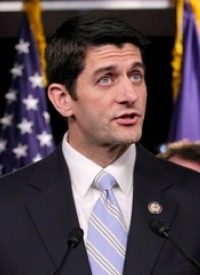
The Ryan budget, proposed by House Budget Committee Chairman Paul Ryan (R-Wis.), would officially increase the national debt by some $5 trillion over the next 10 years and continue $400 billion annual budget deficits through at least 2021. By contrast, Obama's budget proposal would add $9.5 trillion to the deficit over 10 years and never fall below a $500 billion annual deficit despite a series of huge tax increases. (Obama proposed this past week cutting that $9.5 trillion deficit figure by $3-4 trillion with a combination of spending cuts and $1 trillion in additional tax increases.) A Congressional Budget Office analysis of the Ryan proposal concludes that the bill would continue deficit spending until the 2030s; President Obama has yet to propose a budget that would ever balance.
But nearly all of the deficit reduction in both the Obama and Ryan plans is in the "out-years" — i.e., in years after the next election. The Ryan proposal would cut only $80 billion from the cumulative deficit total for fiscal 2012 and 2013, even though that combined deficit will amount to some $1.7 trillion during those two years. Senator Rand Paul (R-Ky.) is the only Senator to introduce a budget proposal that would balance the federal budget within his current elected term, and even Paul's proposal wouldn't balance the budget until 2016 (and would have a combined deficit of $950 billion during fiscal 2012-13, about half the expected deficit in the other plans).
It's long been commonplace for Congressmen to spend profligately in the present while pledging restraint in the future. Indeed, according to President Obama's first budget proposal, submitted back in 2009, the deficit for 2012 would be $557 billion, about half Obama's current projection, more than $400 billion lower than the $995 billion in the Ryan proposal, and about the same as the $553 billion in the Rand Paul plan.
Representative Ron Paul (R-Texas), the Tea Party godfather, voted against both the Ryan and the Obama budget proposals. He told a New Hampshire audience April 15 that "neither of those budgets will solve our problems, or even come close." Fox News talk-show host and possible presidential candidate Mike Huckabee also criticized the Ryan proposal as not being aggressive enough on spending and entitlements, and suggesting that Ryan should have added a provision to bump the Medicare eligibility age up to 70.
Many conservatives backed the Ryan bill in the House as the only alternative being offered to the Obama budget (other than two Democratic substitutes that called for even more spending than the Obama proposal). The House did not hold a vote on the Rand Paul budget proposal. Tea Party-aligned Rep. Justin Amash (R- Mich.) rationalized his vote in favor of the budget as an improvement over Obama's proposal and a starting point for deeper cuts. He wrote to supporters on his Facebook page: "It's far from ideal but fundamentally better than recent budgets. It cuts $5.8 trillion over 10 years, reducing spending to below 20% of GDP vs. 23%+ in the President's budget. It reforms Medicare/Medicaid and defunds last year's health care legislation. It also lowers corporate and individual top tax rates to 25%, which will help manufacturing and small business."
Amash's strategy may have some merit, if he follows through with a push for more cuts. Budget resolutions technically don't spend any money; they are a blueprint for congressional committees which must later be filled in with authorization (program rules) and appropriations (spending) bills in order for federal funds to be spent. Amash and other conservatives could back the Ryan plan as the best of poor alternatives and then push for further cuts in the authorization and appropriations processes. Whether they will do that or not is yet to be seen.
The Ryan budget proposal would indeed cut $5.8 trillion from President Obama's budget proposals over 10 years, but it wouldn't cut spending in an absolute sense except a slight cut from "stimulus"-era spending in the short term. The Ryan budget would cut federal spending from $3.62 trillion in fiscal 2011 to $3.56 trillion in 2013, but then increase spending dramatically after that period. The Obama budget also cuts federal spending slightly from fiscal 2011-13.
But these spending and deficit numbers in the Obama and Ryan budget proposals rely upon continued favorable interest rates for financing the U.S. debt. Interest rates have been at historic lows in recent years. A rise of one percent in the interest rate in financing the national debt would mean an extra $140 billion in "spending" that is not accounted for in any of these budgets, and which would be added onto the deficit.
The four Republicans members of the House who voted against the Ryan budget proposal were Ron Paul (Texas), Denny Rehberg (Mont.), Walter Jones (N.C.), and David McKinley (W.Va.).
Photo of Rep. Paul Ryan: AP Images
Related articles:
CBO Finds $37.5B in "Cuts" Were Gimmicks, 2011 Budget Increases Spending
Tea Party Activists Boiling Over Budget Compromise
More Proof the Budget Deal Was a Scam
Obama Proposes Budget “Cuts” (i.e., Spending Increases and Tax Increases)



